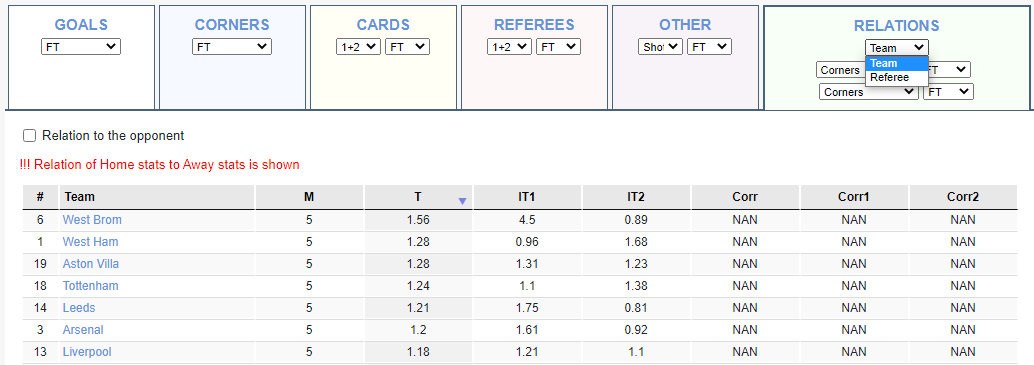Hotline
Hotline


Team
Referee
Compare Teams
Select Tournament
Main
England Spain Germany Italy France Ukraine Russia JapanClub International
World Europe South-america Asia Nc-america Africa OceaniaNational teams
World (National) Europe (National) South America (National) Asia (National) NC America (National) Africa (National) Oceania (National)Europe
Austria Azerbaijan Belarus Belgium Bosnia-herzegovina Bulgaria Croatia Cyprus Czech-republic Denmark Estonia Finland Georgia Greece Hungary Iceland Ireland-republic Israel Kazakhstan Latvia Lithuania Netherlands Northern-ireland Norway Poland Portugal Romania Scotland Serbia Slovakia Slovenia Sweden Switzerland Turkey WalesSouth America
Argentina Bolivia Brazil Chile Colombia Ecuador Paraguay Peru Uruguay VenezuelaAsia
Australia Bahrain China-pr Chinese-taipei Hong-kong India Indonesia Korea-republic Qatar Saudi-arabia Singapore Tajikistan Thailand Turkmenistan United-arab-emiratesNorth Central American and Caribbean
Canada Costa-rica El-salvador Honduras Mexico Nicaragua United-statesAfrica
Algeria Egypt Morocco Nigeria South-africaOceania
New-zealandAnalytics
Among other things, national team matches are also distinguished by a wide range of opponents. That is, a statistically average..
TOP MATCHES
| 19:45 |
|
Genoa VS Atalanta Free! |
Referees statistics relations
The Corner-stats.com team is introducing a new service feature - relations between referees statistics across football tournaments. As you know, the referee of a football match is one of the most important factors in the number of cards and fouls in a match, so the new function in the statistics relations tool will undoubtedly come in handy when predicting violations in football.
You can find the relations of the referees statistics on the Relations tab of the tournament page by selecting the Referee from the dropdown list. You have the ability to compare different combinations of cards and fouls, and, like for teams, you can choose statistics by halves.

We have identified the referee statistics relations that may be of most interest to you:
- fouls to cards (on average how many fouls the referee has on 1 card)
- yellow cards to red ones (on average, how many yellow cards the referee has for 1 red)
- cards of the 1st half to the cards of the 2nd half (this relation is very useful when analyzing the distribution of referee cards by half).
In addition, please note that you can also analyze the correlation of the referees statistics (the impact of one statistic on another). For example, usually, if there are many fouls in a match, then there will be many cards, but there are referees for whom this rule does not apply (correlation is about 0 or negative). Also, the correlation of cards by halves helps to find out whether the referee is inclined to show cards in one of the halves (the correlation is negative) or cards are distributed more or less evenly during a match (the correlation is positive).
We hope that the new functionality will be useful to you and will help you develop new strategies for more accurate forecasting of cards and fouls in upcoming football matches.



 Aston Villa - Man Utd
Aston Villa - Man Utd

 Hertha Berlin - Arminia Bielefeld
Hertha Berlin - Arminia Bielefeld
.png) Jordan - Morocco
Jordan - Morocco Racing Santander - Villarreal
Racing Santander - Villarreal
 Braga - CD Santa Clara
Braga - CD Santa Clara
 88'
88'